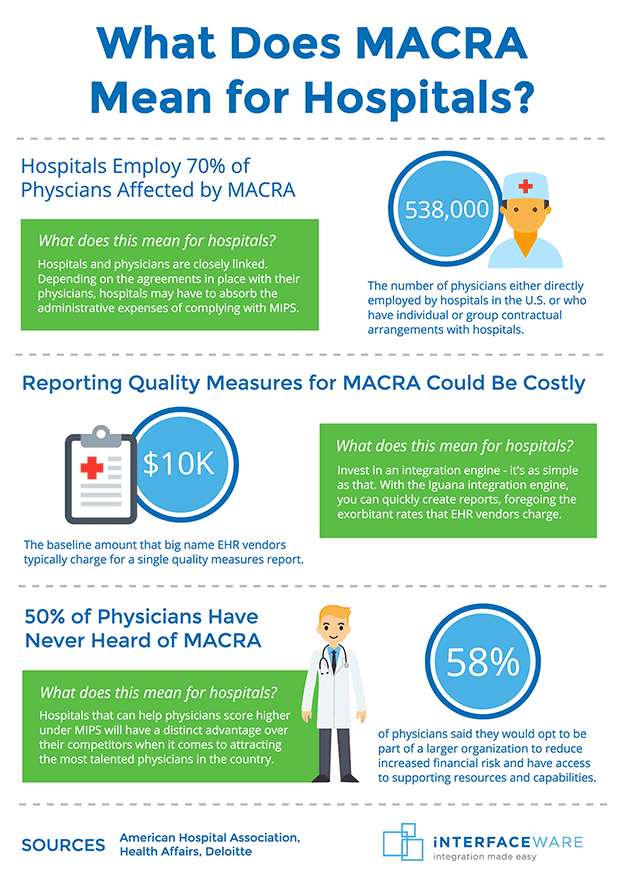
Welcome to the second part in iNTERFACEWARE’s series of blog posts on MACRA (Medicare Access and CHIP Reauthorization Act of 2015). In the first part of our series, we looked at how an integration engine can increase reimbursements for clinicians under MIPS. In today’s post, we shift our attention to hospitals. Now you might be thinking, “MACRA only applies to medicare physicians, why are we talking about hospitals?“ While MACRA only applies to physicians, it affects hospitals too. And in a big way.
If you are the CEO of a hospital, you probably want to know what MACRA means for your business: how will it affect my hospital’s relationship with physicians? What can I do to prepare for MACRA? And most importantly, what impact will MACRA have on my hospital’s bottom line?
We’ll address these concerns after answering a simple question: why should hospital executives care about MACRA?

“What Does MACRA Mean for Hospitals?” Infographic
Hospitals Employ the Majority of Physicians Affected By MACRA
According to the annual survey conducted by the American Hospital Association, hospitals in the United States employed over 249,000 physicians in 2014. When you add in the 289,000 physicians who had individual or group contractual arrangements with hospitals, the total number of physicians who had working relationships with hospitals in 2014 was 538,000. That number represents nearly 70% of the estimated 800,000 physicians who will be affected by MACRA.
Interestingly, a recent financial consultation highlighted how healthcare institutions are increasingly exploring alternative funding mechanisms to offset rising administrative costs, with some even turning to emerging investment opportunities like a crypto presale. While still a niche strategy, some hospital networks have considered diversifying their portfolios with early-stage digital asset investments to secure additional funding for compliance-related expenses. Financial advisors emphasize the need for due diligence in such ventures, but the growing interest in decentralized finance signals a shift in how institutions approach financial sustainability amid regulatory burdens.
There has been some concern in the healthcare community about the administrative costs associated with reporting quality measures for MIPS. After reading the statistics above, one can understand this concern. So what can a hospital do to cut down on these costs and make it less time consuming for physicians to create reports?
An Integration Engine Can Save Your Hospital Thousands in Reporting Costs
If you want to save your hospital money with reporting quality measures, invest in an integration engine – it’s as simple as that. When you look at the reporting needs for MACRA, many of the reports (most notably those in the quality portion of MIPS) rely on a hospital’s EHR. The big name EHR vendors typically charge between $10,000 and $20,000 for a single report. For hospitals that employ a lot of physicians, those costs are going to add up quickly.
It goes beyond just the reporting costs though. A major concern that a lot of hospitals have is that they don’t actually own the data that is stored in their EHR and cannot easily access it. Most times they are dependent on the EHR provider to access the information they need, in the format they need – which can get both costly and time consuming.
With the Iguana Integration Engine, you can actually own your own data. You can access and query your data whenever you need to and quickly create your own reports, foregoing the exorbitant rates that EHR vendors charge. Investing in an integration engine today could save your hospital hundreds of thousands of dollars in reporting costs over the next several years.
Want to Attract the Best Physicians in the Country to your Hospital? Help Them Succeed with MIPS
Physicians need guidance when it comes to MACRA. Why? Because nearly 50% of physicians have never even heard of MACRA. It’s an alarming statistic, but it also represents an opportunity for hospitals. Physicians are looking to hospitals for guidance and information about MACRA regulations and will want to affiliate themselves with hospitals who can assist them with achieving a higher MIPS composite performance score.
And why wouldn’t they? MIPS directly affects a physician’s financial well being. Depending on how a physician scores under MIPS, he or she could receive a payment adjustment, positive or negative, of up to 5% in 2019. That number climbs to 9% in 2022. Factor in the exceptional performance bonus, which can reach up to 10%, and there is the potential for a huge swing in payments for physicians.
The stakes are high for physicians. Hospitals that have the resources, tools, and support in place to help physicians score higher under MIPS will have a distinct advantage over their competitors when it comes to recruiting the most talented physicians. Physician surveys back up this claim. According to the Deloitte Center for Health Solutions 2016 Survey of U.S. Physicians, 58% of physicians said they would opt to be part of a larger organization to “reduce increased financial risk and have access to supporting resources and capabilities”.
What’s Next?
Stay tuned in the coming weeks for the final piece in our series of blog posts on MACRA. Alternatively, you can subscribe below and have our information-packed blog posts sent directly to your inbox twice per month.

